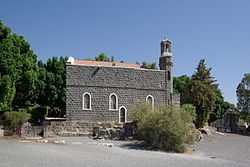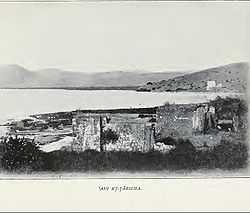Tabgha
| Tabgha | |
|---|---|
|
Tabgha in 1903 | |
 Tabgha | |
| Name meaning | from personal name[1] |
| Subdistrict | Tiberias |
| Coordinates | 32°52′20″N 35°33′00″E / 32.87222°N 35.55000°ECoordinates: 32°52′20″N 35°33′00″E / 32.87222°N 35.55000°E |
| Palestine grid | 201/252 |
| Population | 330[2] (1945) |
| Area | 5 389 (includes Tell el Hunud and Khan el Minya[2] dunams |

Tabgha (Arabic: الطابغة, al-Tabigha; Hebrew: עין שבע, Ein Sheva) is an area situated on the north-western shore of the Sea of Galilee in Israel. It is traditionally accepted as the place of the miracle of the multiplication of the loaves and fishes (Mark 6:30-46) and the fourth resurrection appearance of Jesus (John 21:1-24) after his Crucifixion. Until 1948, it was the site of a Palestinian Arab village.
The site's name is derived from the Greek name Heptapegon ("seven springs"). Its pronunciation gradually changed to "Tabego", and was eventually changed to "Tabha" by the Arabic speakers. St. Jerome referred to Heptapegon as "the solitude" (=eremos).
History
In 1596, Al-Tabigha formed part of the Ottoman Empire, a village, Tabiga, in the nahiya (subdistrict) of Jira under the liwa' ("district") of Safad, with a population of 44. It paid taxes on a number of crops, including wheat and barley, as well as on goats, beehives and orchards.[3][4]
An octagonal reservoir and an aqueduct in the area are traditionally attributed to Aly, a son of Daher el-Omar. According to the Palestine Exploration Fund's Survey of Western Palestine (SWP), this tradition agrees with the masonry of the structures, which indicate an Arab origin.[5] A map from Napoleon's invasion of 1799 by Pierre Jacotin showed Tabgha, named Moulin (=mill).[6]
In the 1922 census of Palestine, conducted by the British Mandate authorities, Tabagha had a population of 175; 157 Muslims and 18 Christians,[7] increasing in the 1931 census, to 245; 223 Muslims, 21 Christians, and 1 Jew, in a total of 53 houses.[8]
On May 4, 1948, just before the outbreak of the Arab-Israeli war, Tabgha was attacked by Palmah forces, supported by the Alexandroni Brigades and local Hagana units. Its Arab inhabitants were expelled and their houses and tents were destroyed under orders by Yigal Allon.[9]
Church of the Multiplication
The earliest building at Tabgha was a small chapel built in the 4th century A.D. (around 350) by the Jewish convert to Christianity, Joseph of Tiberias. According to Epiphanius, Joseph was a contemporary of Emperor Constantine, a Rabbinical scholar, member of the Sanhedrin and a disciple of Hillel II. Following his conversion, Emperor Constantine gave him the rank of count (comes), and gave him permission to build churches in the Galilee, specifically, in Jewish towns which didn't yet have a Christian community, and the Galilee including the Sea of Galilee, was an area with a Jewish majority. This was probably the shrine described by the pilgrim Egeria at the end of the 4th century. The 4th century small shrine was dismounted in 480 and a bigger chapel was built by Martyrius of Jerusalem, Patriarch of Jerusalem from 478 to 486. Martyrius was Egyptian by origin, and this may be the reason why the floor of his chapel was covered with a beautiful Nile mosaic, a style of art popular in the Byzantine time, describing Nilotic landscape and the fest of the Nile.
In the same place (not far from Capernaum) facing the Sea of Galilee is a well watered land in which lush grasses grow, with numerous trees and palms. Nearby are seven springs which provide abundant water. In this fruitful garden Jesus fed five thousand people with five loaves of bread and two fish.—[10]
The mosaic of the fish and loaves is laid next to a large rock, which has caused some New Testament scholars to speculate that the builders of the original church believed that Jesus stood on this rock when he blessed the fish and loaves just before the feeding of the crowd who had come to hear him.
The large monastery and a church were built in the fifth century. While some date the destruction of the site to the time of the Arab conquest, the church was most likely destroyed in 614 during the Persian invasion, for already in AD 670, Bishop Arculf had reported that only columns from the church remained. In any way, by the Crusader conquests the Byzantine site was forgotten, and rediscovered only in the 20th century.
The area's lands were bought in the 18th century by a Catholic German association, so they could build a hotel for pilgrims. As they began digging for the construction they discovered archeological evidence of an earlier church, but could not make excavations due to the {Ottoman law]]. Only in 1932, in the times of Mandatory Palestine. After nearly 1300 years of "solitude", two German archaeologists (Mader and Schneider) uncovered a number of the Byzantine church's walls and mosaics In 1981, after further excavations, the church was finally restored by German Benedictines to its Byzantine form, incorporating portions of the original mosaics.
Today, the church and surrounding land are property of the German Association of the Holy Land whose head is the Archbishop of Cologne. The site is further maintained by Benedictine monks from the Hagia Maria Sion Abbey, also known as Dormition Church, which is located on Mount Zion in Jerusalem.
Church of the Primacy of St. Peter

The Church of the Primacy of St. Peter, north of the Church of the Multiplication, was built on rocks at the shore of the Sea of Galilee, traditionally considered to be the place where Jesus appeared the fourth time after his resurrection (John 21:1-24), during which, according to Catholic teaching, Jesus again conferred primacy on Simon Peter.
An Endemic Shrimp
The Critically Endangered, troglobitic, blind shrimp Typhlocaris galilea is endemic to the Roman Ein-Nur octagonal pool, and a subterranean spring that feeds it, at Tabgha.[11][12]
See also
References
- ↑ Palmer, 1881, p. 135
- ↑ 2.0 2.1 Government of Palestine, Department of Statistics. Village Statistics, April, 1945. Quoted in Hadawi, 1970, p. 73
- ↑ Hütteroth and Abdulfattah, 1977, p. 176. Quoted in Khalidi, 1992, p. 542.
- ↑ Note that Rhode, 1979, p. 6 writes that the register that Hütteroth and Abdulfattah studied was not from 1595/6, but from 1548/9
- ↑ Conder and Kitchener, 1881, SWP I, p. 371
- ↑ Karmon, 1960, p. 166.
- ↑ Barron, 1923, Table XI, Sub-district of Tiberias, p. 39
- ↑ Mills, 1932, p. 85
- ↑ Morris, 2004, p. 250.
- ↑ The Miracle Church at Tabgha on the Sea of Galilee, Bargil Pixner, Biblical Archaeologist, Vol. 48, No. 4 (Dec., 1985) , pp. 196-206
- ↑ Tsurnamal, M. "Temperature Preference of the Blind Prawn, Typhlocaris galilea Calman (Decapoda, Caridea)". Crustaceana 34 (3). Retrieved 2013-05-06.
- ↑ Kloosterman, Karin (2013-05-06). "Blind Shrimp Spared from Extinction at Bible Zoo in Jerusalem". Green Prophet. Retrieved 6 May 2013.
Bibliography
| Wikimedia Commons has media related to Tabgha. |
- Barron, J. B., ed. (1923). Palestine: Report and General Abstracts of the Census of 1922 (PDF). Government of Palestine.
- Burckhardt, Johann Ludwig (1822). Travels in Syria and the Holy Land. J. Murray. (Burckhardt, 1822, p. 318, cited in Khalidi, 1992, p. 542)
- Conder, Claude Reignier; Kitchener, H. H. (1881). The Survey of Western Palestine: Memoirs of the Topography, Orography, Hydrography, and Archaeology 1. London: Committee of the Palestine Exploration Fund.
- Guérin, Victor (1880). Description Géographique Historique et Archéologique de la Palestine (in French). 3: Galilee, pt. 1. Paris: L'Imprimerie Nationale. (pp. 224-226)
- Hadawi, Sami (1970). Village Statistics of 1945: A Classification of Land and Area ownership in Palestine. Palestine Liberation Organization Research Center.
- Hütteroth, Wolf-Dieter; Abdulfattah, Kamal (1977). Historical Geography of Palestine, Transjordan and Southern Syria in the Late 16th Century. Erlanger Geographische Arbeiten, Sonderband 5. Erlangen, Germany: Vorstand der Fränkischen Geographischen Gesellschaft. ISBN 3-920405-41-2.
- Karmon, Y. (1960). "An Analysis of Jacotin's Map of Palestine" (PDF). Israel Exploration Journal 10 (3,4): 155–173; 244–253.
- Khalidi, Walid (1992). All That Remains: The Palestinian Villages Occupied and Depopulated by Israel in 1948. Washington D.C.: Institute for Palestine Studies. ISBN 0-88728-224-5.
- Mills, E., ed. (1932). Census of Palestine 1931. Population of Villages, Towns and Administrative Areas (PDF). Jerusalem: Government of Palestine.
- Morris, Benny (2004). The Birth of the Palestinian Refugee Problem Revisited. Cambridge University Press. ISBN 978-0-521-00967-6.
- Oliphant, Laurence (1887). Haifa, or Life in Modern Palestine. Edinburgh: Blackwood. (Oliphant, 1887, p. 227; cited in Khalidi, 1992, p. 542)
- Palmer, E. H. (1881). The Survey of Western Palestine: Arabic and English Name Lists Collected During the Survey by Lieutenants Conder and Kitchener, R. E. Transliterated and Explained by E.H. Palmer. Committee of the Palestine Exploration Fund.
- Pringle, Denys (1998). The Churches of the Crusader Kingdom of Jerusalem: L-Z (exluding Tyre) II. Cambridge University Press. ISBN 0 521 39037 0. (Pringle, 1998, pp. 334- 339)
- Rhode, Harold (1979). Administration and Population of the Sancak of Safed in the Sixteenth Century. Columbia University.
- Robinson, Edward; Smith, Eli (1841). Biblical Researches in Palestine, Mount Sinai and Arabia Petraea: A Journal of Travels in the year 1838 3. Boston: Crocker & Brewster. (Robinson and Smith, 1841, vol 3, pp. 197-8, cited in Khalidi, 1992, p. 542)
External links
- Welcome To al-Tabigha
- Survey of Western Palestine, Map 6: IAA, Wikimedia commons
